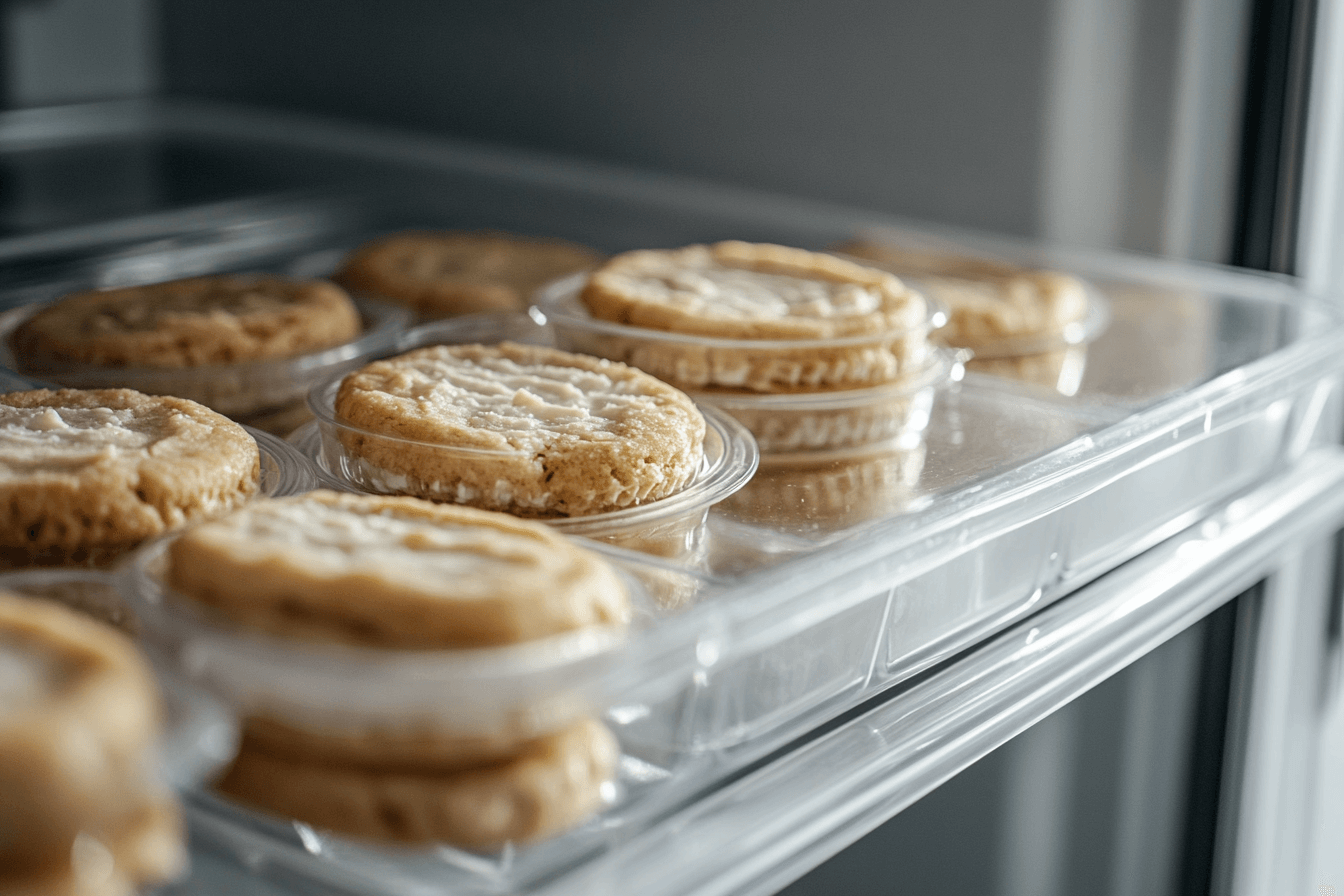Cream cheese filled cookies are a delightful treat, combining the creamy richness of dairy with the comforting texture of baked goods. However, one pressing question often arises when indulging in these cookies: do cream cheese filled cookies need to be refrigerated? This article Innovates the role of cream cheese in baking, food safety concerns, and the best practices for storage. By understanding these aspects, you can include your cookies remain fresh, flavorful, and safe to eat. Let’s dive in!
Table of contents
Understanding Cream Cheese in Baking
The Role of Cream Cheese in Cookies

Cream cheese isn’t just a filler; it’s a game-changer. This creamy, tangy dairy product adds a velvety richness to baked goods, elevating their flavor and texture. In cookies, it creates a moist and tender crumb while offering a slight tang that balances the sweetness. When used as a filling, it complements the cookie dough’s crunch or chew, resulting in a delightful contrast.
However, its dairy origin makes it perishable. Cream cheese is high in moisture, which is a haven for bacteria if not stored correctly. Therefore, understanding how cream cheese behaves during and after baking is essential for ensuring food safety.
Perishability of Dairy Products in Baked Goods
Dairy-based ingredients like cream cheese are inherently unstable at room temperature. Unlike shelf-stable ingredients such as sugar or flour, cream cheese has a short shelf life when exposed to warm conditions. During baking, the high temperatures destroy most bacteria, but the risk returns as the cookies cool.
The moisture content in cream cheese can lead to rapid bacterial growth if left out for too long, particularly in environments above 40°F (4°C). This perishability makes proper storage crucial to prevent spoilage, mold growth, and potential foodborne illnesses.
By understanding the characteristics of cream cheese and its role in baking, we set the stage for addressing the storage practices that include your cream cheese filled cookies stay safe and delicious.
Food Safety Guidelines for Cream Cheese Filled Cookies
USDA Recommendations on Dairy-Based Fillings
When it comes to food safety, the USDA has clear advice: perishable dairy products like cream cheese should not sit out at room temperature for more than two hours. This guideline applies even after baking. While the high heat during baking destroys harmful bacteria, the filling can quickly become unsafe if left unrefrigerated after the cookies cool.
For cream cheese filled cookies, this means that once they’ve been baked and cooled, they must either be served immediately or stored in a refrigerator. Allowing them to sit at room temperature for too long can lead to spoilage, increasing the risk of foodborne illnesses caused by bacteria like Listeria or Salmonella.
The Temperature ‘Danger Zone’ and Its Implications
The “danger zone” for food, as defined by food safety experts, ranges between 40°F and 140°F (4°C to 60°C). Within this range, bacteria can multiply rapidly, doubling in number every 20 minutes. For cream cheese filled cookies, leaving them out in this temperature range can lead to unsafe levels of bacteria growth.
If you’re wondering, “Do cream cheese filled cookies need to be refrigerated?”—the answer lies in this very concept. Refrigeration slows bacterial growth, keeping your cookies fresh and safe to eat for several days. By adhering to food safety guidelines, you can enjoy your cookies worry-free.
Storage Practices for Cream Cheese Filled Cookies
Room Temperature Storage: Time Limits and Risks
Although it’s tempting to leave your cookies on the counter for easy access, it’s not always safe. At room temperature, cream cheese filled cookies can only sit out for up to two hours. Beyond this point, the risk of spoilage increases dramatically.
Cookies stored in warm, humid environments are particularly prone to developing mold or a sour taste due to bacterial growth. If you’re hosting an event, consider placing the cookies on a chilled tray or serving them straight from the refrigerator to reduce this risk.
Refrigeration: Methods and Benefits
The best way to store cream cheese filled cookies is in an airtight container in the refrigerator. This method protects them from exposure to air and moisture, which can accelerate spoilage. Refrigeration not only preserves the texture and flavor but also keeps the filling fresh and safe for up to five days.
When refrigerating, stack cookies with parchment paper between layers to prevent sticking. Additionally, include the container is sealed tightly to maintain the cookies’ moisture and prevent them from absorbing other odors in the fridge.
Freezing Cream Cheese Filled Cookies for Extended Shelf Life

Want to save some cookies for later? Freezing is an excellent option. Place the cookies in a single layer on a baking sheet to freeze them initially, then transfer them to a freezer-safe bag or container. Properly frozen cream cheese filled cookies can last up to three months without losing quality.
Before serving, thaw the cookies in the refrigerator overnight. This gradual thawing prevents condensation from affecting the cookie’s texture. So, do cream cheese filled cookies need to be refrigerated? If they’re not being consumed immediately, yes—and freezing is an even better option for long-term storage.
Factors Influencing the Need for Refrigeration
Moisture Content and Spoilage Rates
The moisture content in cream cheese filled cookies plays a significant role in determining their shelf life. Higher moisture levels create an environment conducive to bacterial growth, leading to quicker spoilage. Therefore, cookies with moist fillings are more perishable and require refrigeration to maintain freshness and safety.
When considering, “Do cream cheese filled cookies need to be refrigerated?”, it’s essential to assess the moisture content. Cookies with a drier texture may have a slightly longer shelf life at room temperature, but those with creamy, moist fillings should be refrigerated promptly to prevent spoilage.
Environmental Conditions: Humidity and Temperature
Environmental factors such as humidity and temperature significantly impact the shelf life of cream cheese filled cookies. In warm, humid climates, the risk of bacterial growth increases, making refrigeration even more crucial. High humidity can cause cookies to become soggy, further promoting spoilage.
To maintain the quality of your cookies, store them in a cool, dry place if refrigeration is not immediately available. However, for optimal safety and longevity, placing them in the refrigerator is advisable, especially in environments prone to high temperatures and humidity.
For more delicious recipes, check out our Cream Cheese Stuffed Red Velvet Cookies article.
Best Practices for Serving Cream Cheese Filled Cookies
Preparing Cookies for Serving After Refrigeration
Serving cream cheese filled cookies after refrigeration requires a bit of preparation to include they taste their best. Remove the cookies from the refrigerator and let them sit at room temperature for about 15-20 minutes. This allows the filling to soften slightly, enhancing the overall texture and flavor.
Avoid microwaving the cookies to speed up the process, as this can cause uneven heating and may alter the texture of both the cookie and the filling. Patience is key to enjoying these treats at their finest.
Maintaining Optimal Texture and Flavor
To preserve the optimal texture and flavor of your cream cheese filled cookies, consider the following tips:
- Proper Storage: Store cookies in an airtight container to prevent them from drying out or absorbing odors from other foods.
- Layering: Place parchment paper between layers of cookies to prevent sticking and maintain their appearance.
- Serving Suggestions: For an added touch, dust the cookies with powdered sugar or serve them with a side of fresh fruit to complement the creamy filling.
By following these best practices, you can include that your cream cheese filled cookies remain a delightful treat for any occasion.
For more delicious recipes, check out our Cream Cheese Stuffed Red Velvet Cookies article.
Common Questions About Cream Cheese Filled Cookies (FAQ Section)
How long can cream cheese filled cookies sit out at room temperature?
Cream cheese filled cookies should not sit out at room temperature for more than two hours. After that, bacteria can start to grow, increasing the risk of foodborne illness. So, do cream cheese filled cookies need to be refrigerated? Absolutely—especially if they won’t be consumed immediately.
Can I use low-fat cream cheese to reduce spoilage risk?
While low-fat cream cheese has slightly less moisture, it doesn’t eliminate the need for refrigeration. The same safety guidelines apply to both regular and low-fat versions, as bacteria can still grow if the cookies are left out for too long.
Is it safe to leave cream cheese filled cookies out overnight?
No, leaving cream cheese filled cookies out overnight is not safe. Even though they’ve been baked, the creamy filling can spoil quickly when exposed to room temperature for extended periods.
How can I tell if my cream cheese filled cookies have spoiled?
Signs of spoilage include an off smell, discoloration, or a slimy texture. If in doubt, it’s better to err on the side of caution and discard the cookies.
What are the best storage containers for these cookies?
Airtight containers work best for storing cream cheese filled cookies. They keep out air and moisture, preserving freshness and flavor. For added safety, store them in the refrigerator or freezer.
Final Thoughts and Additional Tips
Wrapping It All Up

The question, “Do cream cheese filled cookies need to be refrigerated?”, boils down to food safety and freshness. Because cream cheese is a perishable dairy product, refrigerating these cookies is essential to prevent spoilage. Not only does this include safety, but it also preserves their delightful taste and texture.
A Final Word on Storage and Enjoyment
When handling cream cheese filled cookies, always prioritize safe storage practices. Whether you’re refrigerating them for short-term use or freezing them for a future treat, proper handling can make all the difference. And when you’re ready to serve, a little preparation goes a long way in ensuring they taste as amazing as when freshly baked.
For more delightful dessert ideas, check out our Decadent Chocolate Chip Cookies Recipe. You’ll find inspiration for every occasion!
Tips for Baking Perfect Cream Cheese Filled Cookies
Choosing the Right Ingredients
Baking the perfect cream cheese filled cookies starts with selecting quality ingredients. Cream cheese is the star of the show, so opt for full-fat cream cheese for the creamiest, most flavorful filling. While low-fat options are tempting, they can compromise the richness and texture of the cookies.
For the cookie dough, use high-quality butter, sugar, and flour. If you’re adding extra flavorings like vanilla extract or lemon zest, include they are pure and fresh. These small choices can make a big difference in the final product.
Baking Techniques for Consistent Results
Consistency in baking is all about technique. Keep these tips in mind:
- Chill the Dough: Refrigerate your cookie dough for at least 30 minutes before shaping and baking. This helps maintain the cookie’s structure and prevents spreading during baking.
- Portion Evenly: Use a cookie scoop to includeeven sizes. Uniform cookies bake more consistently and look more appealing.
- Monitor the Bake Time: Overbaking can dry out your cookies, while underbaking may leave them too gooey. Aim for a light golden edge with a soft center.
When you’re done baking, the question “Do cream cheese filled cookies need to be refrigerated?” becomes even more crucial for preserving their quality.
Creative Ways to Serve Cream Cheese Filled Cookies
raise Your Presentation
When it’s time to serve, presentation matters! Arrange your cream cheese filled cookies on a decorative platter, dusted lightly with powdered sugar for an elegant touch. You could also drizzle them with melted chocolate or caramel for added decadence.
For a fun twist, serve the cookies with a small bowl of fruit preserves or a dollop of whipped cream. The tangy filling pairs beautifully with fruity or creamy accompaniments, making the cookies feel even more special.
Pairing Ideas for Any Occasion
Pairing cream cheese filled cookies with the right beverage can raise the experience. A warm cup of coffee or a frothy cappuccino complements the richness of the cream cheese filling perfectly. For non-coffee drinkers, a glass of cold milk or a mug of spiced chai works wonders.
Planning a festive event? Arrange the cookies alongside other desserts, like brownies or tarts, for a visually appealing dessert spread. These cookies are versatile and can easily be the centerpiece of any dessert table.


1 thought on “Do Cream Cheese Filled Cookies Need to Be Refrigerated?”